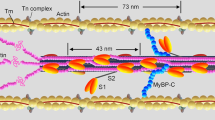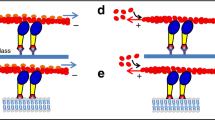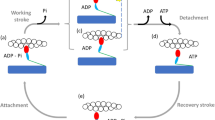Abstract
FORCE generation and relative sliding between the myosin and actin filaments in muscle are thought to be caused by tilting of the head region of the myosin crossbridges between the filaments1–3. Structural and spectroscopic experiments have demonstrated segmental flexibility of myosin in muscle4–6, but have not shown a direct linkage between tilting of the myosin heads and either force generation or filament sliding. Here we use fluorescence polarization to detect changes in the orientation of the light-chain region of the head, the part most likely to tilt5,7,8, and synchronized head movements by imposing rapid length steps9–11. We found that the light-chain region of the myosin head tilts both during the imposed filament sliding and during the subsequent quick force recovery that is thought to signal the elementary force-generating event.
This is a preview of subscription content, access via your institution
Access options
Subscribe to this journal
Receive 51 print issues and online access
$199.00 per year
only $3.90 per issue
Buy this article
- Purchase on Springer Link
- Instant access to full article PDF
Prices may be subject to local taxes which are calculated during checkout
Similar content being viewed by others
References
Huxley, H. E. Science 164, 1356–1366 (1969).
Lymn, R. W. & Taylor, E. W. Biochemistry 10, 4617–4624 (1971).
Huxley, A. F. J. Physiol., Lond. 243, 1–43 (1974).
Reedy, M. K., Holmes, K. C. & Tregear, R. T. Nature 207, 1276–1280 (1965).
Cooke, R. CRC Crit. Rev. Biochem. 21, 53–118 (1986).
Thomas, D. D. A. Rev. Physiol. 49, 691–709 (1987).
Vibert, P. & Cohen, C. J. Muscle Res. Cell Motil. 9, 296–305 (1988).
Rayment, I. et al. Science 261, 58–65 (1993).
Huxley, A. F. & Simmons, R. M. Nature 233, 533–538 (1971).
Huxley H. E. et al. J. molec. Biol. 169, 469–506 (1983).
Irving, M., Lombardi, V., Piazzesi, G. & Ferenczi, M. A. Nature 357, 156–158 (1992).
Lombardi, V., Piazzesi, G. & Linari, M. Nature 355, 638–641 (1992).
Lombardi, V. et al. Nature 374, 553–555 (1995).
Irving, M., Kendrick-Jones, J., Shrimpton, C. & Sleep, J. J. Physiol. 418, 57P (1989).
Sabido-David, C. et al. Biophys. J. 66, A234 (1994).
Berger, C. L., Karki, S. & Goldman, Y. E. Biophys. J. 66, A189 (1994).
Xie, X. et al. Nature 368, 306–312 (1994).
Lowey, S., Waller, G. S. & Trybus, K. M. Nature 365, 454–456 (1993).
Tregear, R. T. & Mendelson, R. M. Biophys. J. 15, 455–467 (1975).
Cooke, R., Crowder, M. S. & Thomas, D. D. Nature 300, 776–778 (1982).
Huxley, H. E. & Kress, M. J. Muscle Res. Cell Motil. 6, 153–161 (1985).
Goldman, Y. E. & Simmons, R. M. J. Physiol. Lond. 269, 55–57P (1977).
Higuchi, H. & Goldman, Y. E. Nature 352, 352–354 (1991).
Finer, J. T., Simmons, R. M. & Spudich, J. A. Nature 368, 113–119 (1994).
Ishijima, A. et al. Biochem. biophys. Res. Commun. 199, 1057–1063 (1994).
Dantzig, J. A. & Goldman, Y. E. J. gen. Physiol. 86, 305–327 (1985).
Rowe, T. & Kendrick-Jones, J. EMBO J. 11, 4715–4722 (1992).
Corrie, J. E. T. & Craik, J. S. J. chem. Soc., Perkin Trans. 1, 2967–2974 (1994).
Moss, R., Giulian, G. G. & Greaser, M. L. J. biol. Chem. 257, 8588–8591 (1982).
Lombardi, V. & Piazzesi, G. J. Physiol. 431, 141–171 (1990).
Goldman, Y. E. & Simmons, R. M. J. Physiol. 350, 497–518 (1984).
Goldman, Y. E. Biophys. J. 52, 57–68 (1987).
Chase, P. B. & Kushmerick, M.J. Biophys. J. 53, 935–946 (1988).
Martyn, D. A. & Gordon, A. M. J. gen. Physiol. 99, 795–816 (1992).
Tanner, J. W., Thomas, D. D. & Goldman, Y. E. J. molec. Biol. 223, 185–203 (1992).
Author information
Authors and Affiliations
Rights and permissions
About this article
Cite this article
Irving, M., St Claire Alien, T., Sabido-David, C. et al. Tilting of the light-chain region of myosin during step length changes and active force generation in skeletal muscle. Nature 375, 688–691 (1995). https://doi.org/10.1038/375688a0
Received:
Accepted:
Issue Date:
DOI: https://doi.org/10.1038/375688a0
This article is cited by
-
Single-molecule fluorescence characterization in native environment
Biophysical Reviews (2010)
-
New techniques in linear and non-linear laser optics in muscle research
Journal of Muscle Research and Cell Motility (2006)
Comments
By submitting a comment you agree to abide by our Terms and Community Guidelines. If you find something abusive or that does not comply with our terms or guidelines please flag it as inappropriate.



